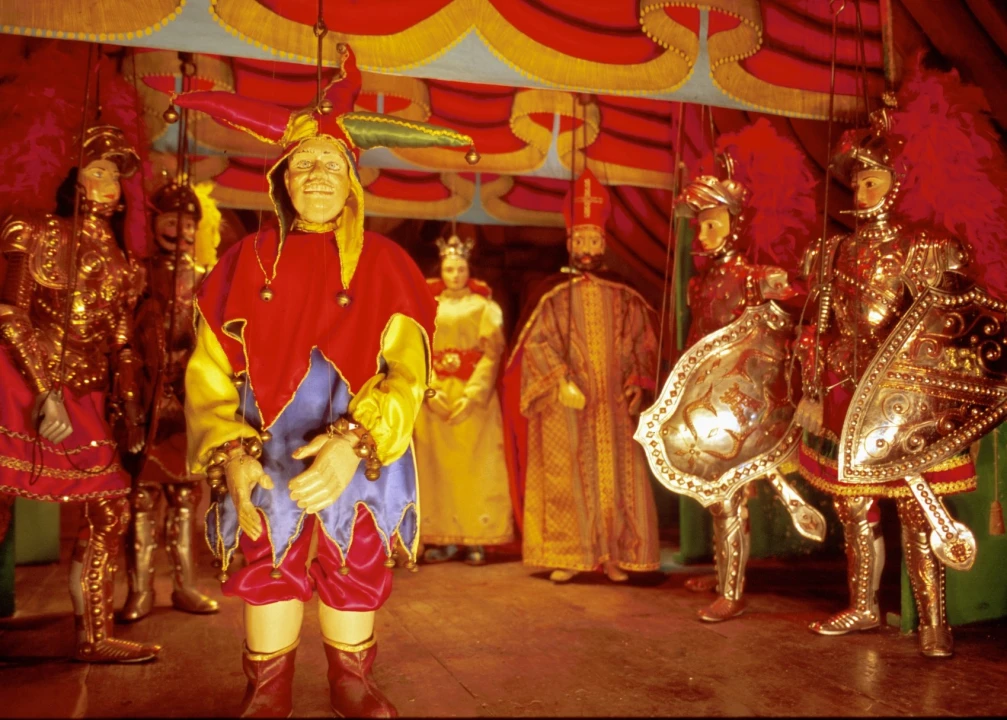The Sicilian Puppet Theatre (Opra) is a characteristic theatre performance where the puppets, animated by “puppeteers”, represent the exploits of the greatest medieval heroes who fought for Christendom against the Saracens. In particular, the most recurrent theme in the Opra was the clash between the paladins of Charlemagne and the Muslim warriors who occupied the Iberian Peninsula, representing a real threat to the Frankish kingdom and the whole of Christian Europe.
According to historical tradition, puppet theatre on the subject of chivalry was already known in Spain in 1500s, was introduced to France in the seventeenth century and spread to Italy (Sicily) from the city of Naples in the early decades of the 19th century. On the island it quickly acquired specific characteristics that made the Opera dei Pupi stand out from the generic art of puppetry.
The Sicilian puppets were in fact covered with elaborate metal armour and the right hand wire director was replaced by an iron rod, more suitable for making the puppets' movements direct and precise, especially during fights and duels. Even the moral issues proposed during the shows, always based on a high sense of justice and respect for freedom, were a hallmark of the Opera dei Pupi, which was well in tune with the mood of the Sicilians and thus enjoyed great popularity.
As has often happened in the history and culture of Sicily, the Opera dei Pupi had its centres of interest in the two major cities of the island, where two important theatrical traditions, those of Palermo and Catania, can be distinguished.In both cities, experienced puppeteers taking short stories of predominantly oral tradition as a base, ingeniously adapted and personalised them, proposing plots taken from ancient chivalric literature, in which the Carolingian cycle had a predominant role with the History of the Paladins of France.
The show, which lasted about two hours in three acts, relived the loves and the deeds of kings, heroic Christian champions, Saracens noble, beautiful girls, witches and necromancers who forced the devils to do their bidding, huge giants and terrible dragons.
These characters were all personified by puppets built with great craftsmanship with a skeleton of wood and entirely covered in shiny armour and precious fabrics. Their size and weight was smaller in Palermo (about 80 cm and 13 kg) and greater in Catania (about 1.30 m and 30 kg). Special stage effects were used giving the shows a strong spectacle like the unexpected leakage of blood from wounded or dying puppets, elaborate effects that reproduced fountains from which sometimes blood would gush and the simulation of cities in flames.
The characters of the Puppets were immediately recognisable to the viewer because of their stylised costumes and characteristic voices. A king, in fact, was always dressed in an especially rich and beautiful suit and was recognisable by his crown, which, if surmounted by a cross, indicated the title of Emperor Charlemagne. The Christian knights wore full armour, enhanced by a kilt and cloak, and had voices and faces that were almost always kind; whereas Saracen warriors were immediately recognisable by the typical turban, the crescents on their armour, their faces with big moustaches and their often earthy, guttural voices.
The women warriors wore armour with bouncing breasts and finally the Magonzesi,Christian traitors, were easily recognisable by their evil faces, drooping moustaches, black clothes and the rather macabre insignia on the armour such as the bat.With such features, the Opera dei Pupi spread throughout Sicily from Palermo and Catania to such an extent that, in the late nineteenth century, almost every city on the island boasted local puppeteer companies.
The cultural interest in the Opera dei Pupi developed in Europe during the Romanticism era, reaching important milestones in history especially in France, England and Germany. A period of crisis emerged during the 1950s due to the emergence of cinema and the spread of television and many puppeteer companies abandoned their ancient craft.
The Puppets
The theatre puppets are 120 cm height to the crest and weigh about 12 kg. They are built with a spruce based frame covered with straw and in turn covered with sackcloth. The torso is joined to the limbs and the head with iron rings to simulate the movements of the human body and the armour is all brass. The torso is dressed (with or without armour) depending on the character that it will represent in the show.
The Theatre
In the Sicilian Puppet Theatre, the “manianti” are those who use their hands to move the puppets through the manoeuvring rods and wires. They remain hidden from the public behind “scenes” of the sky and ground, they stand on the raised animation deck called “u scannapoggiu”.
The “parraturi” are those who give the characters their voices, they also improvise dramatic dialogue and assume the role of director of the show itself. The voices take on different timbres and tones from time to time depending on the characters and their part.
The armour is made of brass, copper or nickel silver and fully embossed according to traditional rules inherited from the old masters. The costumes are traditional, trimmed cloaks of kings, fringes and braiding, often painted and embroidered.
By Camera di Commercio di Catania with Unioncamere




